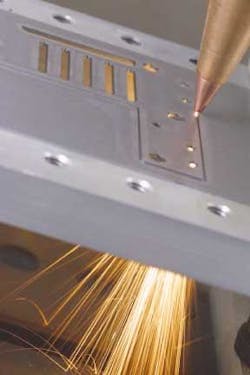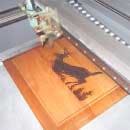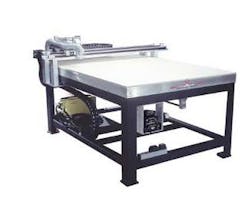Glory days
The day is long past when CO2 lasers were regarded only as sources of raw output power, used primarily to blast through steel plates in a shipyard or weld auto parts. Over the past 15 years RF-excited, sealed CO2 sources delivering between 25 and 500 watts have become increasingly popular for a diverse range of applications in light-duty manufacturing. Today, in fact, unit sales of these lasers far exceed those of their higher-power cousins, and significant growth will likely continue for the foreseeable future.
This growth in low-power CO2 lasers stems from a desire to update and improve light manufacturing production processes. Compared with more powerful gas lasers and solid-state sources, RF-excited, sealed CO2 lasers offer advantages to a range of applications in engraving, marking, cutting, and rapid prototyping.
This diversity of applications leads to a wide range of requirements that could potentially create an overwhelming selection of lasers. However, two resonator technologies—waveguide construction and slab construction—are becoming the leading platforms for these demanding industrial applications.
These two laser architectures have been commercially available from a number of laser suppliers for some time, and both methods have continued to evolve to meet emerging market needs. Today, the highest quality low-power RF-excited, sealed CO2 lasers deliver excellent beam and pulse quality in a broad range of output powers. Their compact and rugged construction is available at a reasonable cost, and they provide operating lifetimes in excess of 20,000 hours with minimal maintenance.
Resonator types
Waveguide construction uses a ceramic cavity that has a small cross-sectional area and confines the beam in two directions (x and y), with z being the output direction. To increase output power, waveguide resonators must increase the discharge volume. But because their beam is confined, this is only possible by increasing the length of the cavity. Using multiple mirrors, however, allows the cavity to be folded, thus reducing the overall size of the device. The end result is a more compact resonator that delivers an excellent ratio of power to physical length and weight.
Also, confining the energy in the x and y dimensions produces a high-quality beam that does not require additional optics to produce excellent M2 values. Another attractive feature of this design is the relatively small discharge volume of its gas, which results in excellent rise and fall times. Waveguide resonators can deliver a wide range of power—from 100 percent (CW) to less than 1 percent—smoothly and over the entire operating range.
Slab resonators incorporate two rectangular electrodes separated by a precise gap, resulting in a gain medium geometry that has a high-aspect ratio cross-section typically greater than 20:1. The mirrors are arranged to form a waveguide/unstable resonator, which means that on one axis the electrodes confine the beam and, on the axis perpendicular to the electrodes, the beam is defined by an edge-coupled unstable resonator.
The benefit of this design is that power scales in relation to the area of the electrodes, allowing slab lasers to maintain cost effectiveness as they scale up to 500W. Water-cooled designs can produce high peak power for long times, thus enabling the high average power required in many cutting applications.
Applications
Low-power lasers are becoming a common technology for marking and coding a variety of materials in production environments. They are non-contact, use no consumables, and can be configured for high throughput.
Laser selection depends on factors such as the nature and quality of the intended mark, the substrate material, and space and throughput requirements. While wavelength, output power, and beam quality determine which technology works best, cost is often a significant factor as well. A benefit of all sealed CO2 lasers is their cost per watt, which can be almost an order of magnitude lower than that of Q-switched solid-state lasers.
Both waveguide and slab CO2 laser designs work well in marking applications that suit the 10.6 µm wavelength. Users requiring a small amount of power will find that waveguide lasers in the power range from 25- to 100-W provide a compact, air-cooled, low-cost, and highly reliable solution. Above 100 watts, slab laser technology provides an advantage, particularly if the customer wishes to perform cutting applications on the same machine that's used for marking.
Engraving, essentially "deep marking," usually creates a pattern by removing or ablating material from a substrate. Laser systems produce words or images from a series of dots scribed by a modulated beam, usually raster scanned across a surface.
Most engraving shops are small, cost-conscious operations primarily interested in processing more material in less time and at a low cost. These demands, combined with the limited floor space of most engraving shops, enhance the value of lasers that can produce relatively higher powers from a smaller package size. More power permits faster processing of a broader range of materials, although few engravers require lasers with outputs higher than 100 W. Most shops, in fact, rely on output powers between 30 W and 50 W. With the advent of compact integrated designs, engraving system suppliers have introduced highly capable desktop-size models up to 50 W in power.
Compact, low-power waveguide resonators are ideal for engraving and other size-sensitive manufacturing environments. Ideally, these lasers should provide fast rise- and fall-times, which translate into higher throughput—the faster the beam is scanned across a plate, the faster the laser tube has to turn on and off to maintain smooth, crisp edges. OEMs in this market currently rely on CO2 lasers that deliver 50-µs rise/fall times, enabling engraving systems that process 120 in./s—double the speeds available a few years ago.
Sealed CO2 lasers are ideal for cutting non-metals and thin metal parts, which are applications where both peak power and average power are essential to high throughput and cut quality. Their excellent M2 values of 1.2 or less also provide a finer "blade" that produces a cleaner cut.
Tight Gaussian-shaped spots and high peak powers confine laser energy to the desired target area and help prevent heat flow from reaching the surrounding material. Reducing the HAZ improves edge quality by not burning the material that surrounds the cut, thus providing a better surface finish and tighter tolerances. Higher average power is also essential to throughput. By delivering high peak power at high repetition rates, users can run more material through their production lines. The ability to scale both power and repetition rate in a cost-effective way enables OEMs to provide very competitive cutting equipment.
Rapid prototyping systems modify materials by scanning patterns of laser energy onto a polymer material to form precise solid replicas of a computer-designed part. This technique requires keeping the polymer temperature uniform, which, requires tight control over the rate of exposure. The goal is to get the right amount of light to the right area for the right amount of time.
The output wattage can vary according to the application but, whatever it is, rapid prototyping requires lasers with rise/fall times that are predictable and consistent in terms of both power and timing. Because exposure rates are related to the speed of scanning mirror, the laser's pulse timing must be precise and controllable. That is, lasers modulating within microseconds must have pulse-to-pulse accuracies within a few percent. Better control enables a wider range of prototyping applications. Rapid prototyping also requires lasers with a wide dynamic range, because different polymer materials require different output powers.
Summary
The demands of high-volume OEM markets to fuel the evolution of more versatile and flexible CO2 laser designs. Most of these demands can be met either by slab or waveguide resonators. Either category provides excellent beam quality, pulse shape, and cost-effective output. Sealed CO2 laser selection is simplified by the combined performance range of these resonator technologies, allowing OEMs to base their decision on required output power and cost.
Ron Straayer is a product manager for Coherent DEOS in Bloomfield, Conn. David Clark is Coherent's business development manager for macro materials processing in Santa Clara, Calif. Visit www.coherentinc.com.¡




